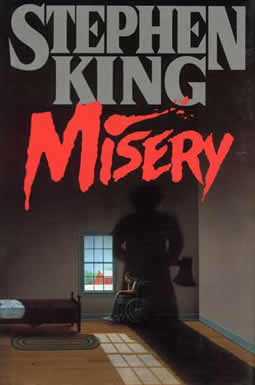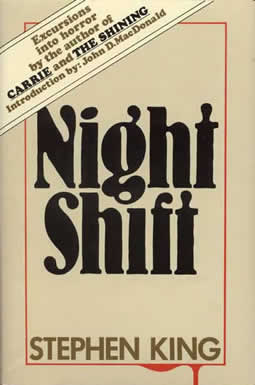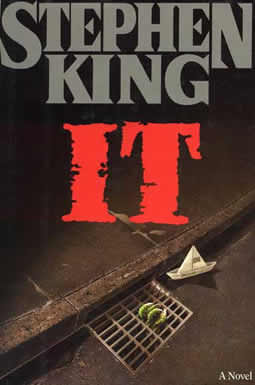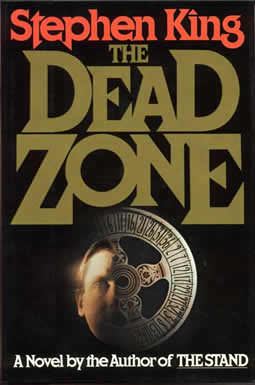Misery
 After being saved from a car accident, novelist Paul Sheldon is taken in and nursed by his number one fan, Annie Wilkes. Under her care, he finishes the final novel in Wilke’s favorite series, starring a character named Misery. Wilkes becomes infuriated by Sheldon’s surprise death of Misery and keeps him captive until he writes another novel bringing Misery to life. King says the inspiration for Misery came from poor fan reception of his books that weren’t horror/thriller focused. It also came from King’s struggle to give up drugs and alcohol.
After being saved from a car accident, novelist Paul Sheldon is taken in and nursed by his number one fan, Annie Wilkes. Under her care, he finishes the final novel in Wilke’s favorite series, starring a character named Misery. Wilkes becomes infuriated by Sheldon’s surprise death of Misery and keeps him captive until he writes another novel bringing Misery to life. King says the inspiration for Misery came from poor fan reception of his books that weren’t horror/thriller focused. It also came from King’s struggle to give up drugs and alcohol.
Take the psychotic nurse in Misery, which I wrote when I was having such a tough time with dope. I knew what I was writing about. There was never any question. Annie was my drug problem, and she was my number-one fan. God, she never wanted to leave.
Night Shift
 King publishes his first collection of short stories in ‘Night Shift’. It includes his work originally published in Cavalier, Urbis, and Penthouse magazines, along with previously unpublished works.
King publishes his first collection of short stories in ‘Night Shift’. It includes his work originally published in Cavalier, Urbis, and Penthouse magazines, along with previously unpublished works.
It
 Twenty-eight years after seven teenagers battled a haunting creature that preyed on children, the group returns as adults to finish what had begun nearly three decades ago as local children begin going missing yet again. They prepare to battle what is lurking in the sewer system as they try to make sure what they thought they’d defeated before was truly vanquished once and for all. In King’s It, the creature often takes form as a clown to attract children, making King one of the first people to paint clowns as a scary figure.
Twenty-eight years after seven teenagers battled a haunting creature that preyed on children, the group returns as adults to finish what had begun nearly three decades ago as local children begin going missing yet again. They prepare to battle what is lurking in the sewer system as they try to make sure what they thought they’d defeated before was truly vanquished once and for all. In King’s It, the creature often takes form as a clown to attract children, making King one of the first people to paint clowns as a scary figure.
As I began to grow up I began to look at kids and I noticed that kids are all terrified of [clowns]. The parents say, “Aren’t the clowns funny, Johnny?”, and Johnny’s like “No! Get me the hell out of here!”
Children of the Corn
King’s Children of the Corn is adapted into a feature-length film. The tale was originally released as a short story in his compilation book, Night Shift. It’s a story of a twelve-year-old preacher who convinces all the kids in a rural neighborhood to kill everyone over eighteen for Jesus. King originally wrote the screen play for the film adaptation of Children of the Corn, but his version was thrown out due to having too much dialogue and back-story. Instead, a much more violent/gory version with more conventional narrative style was written by George Goldsmith and used for the film. Directed by Fritz Kiersch and starring Peter Horton and Linda Hamilton, the film grosses $14.5 million after being made on a minimal budget of $800 thousand.
Christine
John Carpenter directs the film adaptation of King’s novel, starring Keith Gordon. The film grosses $21 million after being made on a $9.7 million budget. King approved of all the work done on the film, apart from one major difference from his original novel. In King’s version, Christine was haunted by the spirit of a previous owner. In Carpenter’s version, the car is haunted from the very moment it’s built. When asked why he made Christine a 1958 Fury:
Because they’re almost totally forgotten cars. They were the most mundane fifties car that I could remember. I didn’t want a car that already had a legend attached to it like the fifties Thunderbird, the Ford Galaxies etc. […] Seriously, I don’t know how Chrysler feels about Christine, anymore than I know how the Ford Company feels about Cujo, in which a woman is stranded in a Pinto. But they should feel happy, because it’s a pretty lively car and it lasts a long time. It’s like a Timex watch, it takes a licking and goes on ticking.
Pet Sematary
After moving from Chicago to Maine, Dr. Louis Creed finds a cemetery the neighborhood kids created for the countless lives of cats and dogs a local high way has taken. Close by, Creed finds another cemetery in the form of an ancient Native American burial ground. After losing his family cat, he learns the connection between the two spooky burial plots.
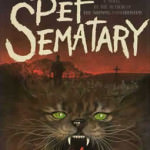
Christine
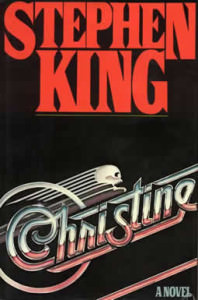 King publishes a thriller of a boy’s new girlfriend and his jealousy-driven car. Dubbed Christine by it’s previous owner, the car is a junker that Arnie fixes up, accidentally making the car fall for him and ultimately try to push away any other woman in his life.
King publishes a thriller of a boy’s new girlfriend and his jealousy-driven car. Dubbed Christine by it’s previous owner, the car is a junker that Arnie fixes up, accidentally making the car fall for him and ultimately try to push away any other woman in his life.
Cujo
 A once-friendly St. Bernard is bitten by a rabid bat and transformed into a murderous killing machine in King’s Cujo. King wrote the book during a period in his life of heavy drinking and recalls that he doesn’t remember writing the novel.
A once-friendly St. Bernard is bitten by a rabid bat and transformed into a murderous killing machine in King’s Cujo. King wrote the book during a period in his life of heavy drinking and recalls that he doesn’t remember writing the novel.
I wish I could remember enjoying the good parts as I put them down on the page.
The Shining
Stanley Kubrick adapts King’s The Shining into a feature film starring Jack Nicholson and Shelly Duvall as young parents who move with their young son to a large abandoned hotel to be caretakers for the winter off season. The film grossed $44.4 million after being filmed for $19 million. The famous line proclaimed by Jack Torrence as he chops down a bathroom door, “Here’s Johnny!” was improved by Nicholson on the spot, originally being inspired by the introduction of The Tonight Show with Johnny Carson. King was disappointed with Kubrick’s decision not to film at the Stanley Hotel and did not like the adaptation, saying that his novel focused on main problems such as the disintegration of a family and the dangers of alcoholism, which, he believes, Kubrick completely ignored.
Parts of the film are chilling, charged with a relentlessly claustrophobic terror, but others fall flat. Not that religion has to be involved in horror, but a visceral skeptic such as Kubrick just couldn’t grasp the sheer inhuman evil of The Overlook Hotel. So he looked, instead, for evil in the characters and made the film into a domestic tragedy with only vaguely supernatural overtones. That was the basic flaw: because he couldn’t believe, he couldn’t make the film believable to others. What’s basically wrong with Kubrick’s version of The Shining is that it’s a film by a man who thinks too much and feels too little; and that’s why, for all its virtuoso effects, it never gets you by the throat and hangs on the way real horror should.
The Dead Zone
https://newslines.org/wp-content/uploads/2014/07/hardcover_prop_embed-5.jpg 385 255 Kathryn Trumbull Kathryn Trumbull2014-07-11 20:06:302014-07-11 20:06:30The Dead ZoneCarrie
Carrie becomes the first of King’s novels to be adapted into a feature film. Directed by Brian Da Palma and starring Sissy Spacek and John Travolta, the film grosses $33.8 million after being filmed on a $1.8 million budget. King believed Da Palma depicted his character perfectly.
Carrie White is a sadly mis-used teenager, an example of the sort of person whose spirit is so often broken for good in that pit of man- and woman-eaters that is your normal suburban high school. But she’s also Woman, feeling her powers for the first time and, like Samson, pulling down the temple on everyone in sight at the end of the book.

